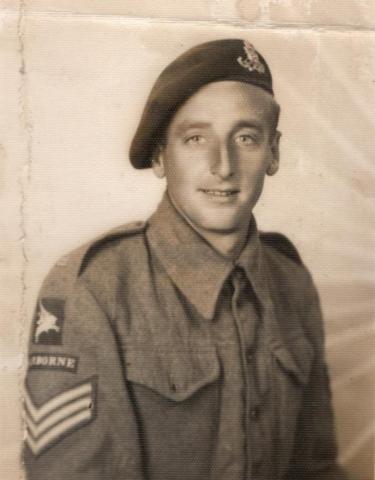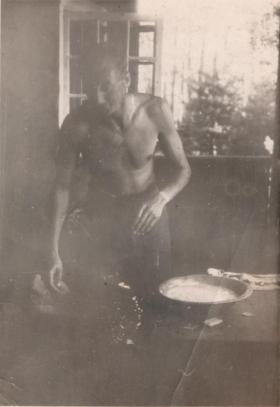Eric Henry Atkinson was born on the 3 June 1919, and came from Tilbury in Essex.
Before he enlisted into the 14th Anti-Tank Militia Cadre, RA, on the 15 July 1939, he had been working as a shop assistant.
He was then posted to ‘C’ Battery, 51st Anti-Tank Training Regiment, R.A. on the 30 September 1939.
On the 24 January 1940 he was posted to his operational unit, the 223rd Battery, 56th Anti-Tank Regiment, R.A. With this unit he went to join the British Expeditionary Force in France on the 20th April 1940. The Germans launched their attack upon the ‘West’ on the 10 May 1940, and the resultant disastrous campaign saw the Battery, and the Regiment driven back to Dunkirk, from where ‘Herbie’ was evacuated on the 3 June 1940.
He was still serving with the 223rd Anti-Tank Battery, RA when it was given an Independent role and in late 1941 was converted to the Airborne role, and renamed the 1st Airlanding Anti-Tank Battery, RA.
He is officially listed as serving in North Africa from the 14 April 1943 until the 5 January 1944. This does not reflect the fact that took part in two military operations during this period. The first being the airborne operation – codenamed ‘Fustian’ - to capture the bridge at Primosole on the night of 13/14 July 1943, where the 1st Airlanding Anti-Tank Battery was in support of the 1st Parachute Brigade. The second being Operation ‘Slapstick’ which was the 1st Airborne Division seaborne landing at Taranto, Southern Italy in September 1943.
After returning to the United Kingdom and getting ready for several planned operations he eventually took off from RAF Manston for Operation ‘Market-Garden’, on Sunday, 17 September 1944. He was aboard a Horsa glider, Chalk Number 336, with a jeep and 6-pounder anti-tank gun and two of his gun crew. The glider pilots, S/Sgt. Rupert Goldsack and Sgt. Laurie Foster, were from ‘B’ Squadron, The Glider Pilot Regiment. They were being towed by an Albemarle aircraft of 296 Squadron being flown by Flying Officer Wood. They had taken off at 11.08 hrs, but at 13.00 hrs the tug aircraft developed engine problems and they had to cast off. The glider landed in the Dutch Province of Brabant, near the village of Macharen, just south of the river Maas, halfway between Hertogenbosch and Arnhem. Both glider pilots and their passengers spent one or two nights in a Monastery. From there they were escorted by members of the Dutch underground movement to Grave where they linked up with the American 82nd Airborne Division.
A few days later ‘Herbie’ was involved in an accident and was evacuated back to England on the 28 September 1944.
His next operational deployment was to Norway as part of Operation ‘Doomsday’, on the 10th May 1945. He remained there until the 29th August 1945, before again returning to the United Kingdom.
Although his service with airborne forces was over soon after, he continued with the Army and served in Germany from the 27 November 1945 until the 9 February 1946, before returning to England for the final time. He was released to the ‘Z’ Reserves on the 5th May 1946.
Upon his discharged his Military Conduct stated, ‘Exemplary’ and his Testimonial by the O/C 1st Airlanding Anti-Tank Bty, R.A. read:
“An NCO of extremely good character and capabilities. He is of more than average intelligence and possesses tact and powers of command. 100% reliable and trustworthy. Good soccer player”.
This is own personal account of his service, sent to ‘Bob’ Hilton on the 20 July 1995:
“Thank you very much for you kind letter and for your interest in my old battery. As you will realise I am now 76 years old and my memory is not so good, but will do my very best to give you your information if I can. I can start with 56 A/TK Regt. It was formed in Barrow-in-Furness and surrounding areas as 4th or 5th Kings Own TA and then to 56 A/TK Regt. It consisted of shipyard workers and office staff. When I joined the Regiment in January 1940 it was in Wiltshire around Wantage, Sevenoak Forest. 223 Battery was at Burbage, and were billeted in horse racing stables as were the whole Regiment.
“We went to France round about March 1940 (approx.) we were stationed just outside Lille in Lambersart when things started, we moved up to Reboux in Belgium and finally ended up in Hazelbrock marshalling yards where we were told ‘every man for himself’ after being overrun, and so on to Dunkirk and England. We were reformed in Darlington in 1940, and then made into 223 Independent A/TK Bty, RA of the 31st Independent Brigade. We were told we [were] a flying column in case of invasion and could be ready at very short notice and moved down to the Kent coast and dug gun positions all around the area. We moved to South Wales and then on to Bulford in Wilts in 1942 to be formed into 1st Airlanding Brigade as part of 1st Airborne Division.
“After a lot of training etc., we left for North Africa in 1943. I got married 10th March just before we left. After a lot of here and there in North Africa, all of the 1st A/B Div. was stationed around Sousse where we took off for the Sicily operation. Our objective being the Primsole Bridge over the River Simeto just below Catania. I think most of ‘B’ Troop took off in WACO’s (Yanks) which only took a gun or a jeep with the gun team split and of course some had a gun and no jeep, some had a jeep and not gun. ‘A’ Troop had all Horsa’s towed by the RAF (what luck). My glider (A1) landed rather badly a few yards from the bridge, all the flooring pushed up our 6 pounder under the main wing span which ran through the glider, we got the jeep out, but the gun took us a long, long time under fire. Eventually I ended up on the high ground along with 2nd Para Bn.
“I would like to point out the operation was at night, no moon, we were fired on by our Navy over the Mediterranean. The Yanks even took some Para’s back to Sousse, some gliders were found with tow ropes still attached. The whole of the zone was full of flak and fire. Thank God for the RAF. My gun team was Bdr. W Cotteral, Dvr. ‘Lofty’ Reed, Gnr. F. White and Gnr. Willshaw. Out of my glider the following won these awards:
“Glider Pilot S/Sgt. F. White DFC, Dvr ‘Lofty’ Reed MM, (He was later made up to Sgt), The Troop Commander Lt E. E. Clapham MC. I was made up to full Sgt as Sgt Stubbs was our own Team Sgt, but went sick so as L/Sgt I took over, Sgt ‘Mush’ Anderson had A2 gun I think, he landed alongside the bridge, he won the MM. Sgt Hills had A3 gun, they hit the bank and crashed, killing Sgt Little, Gnr Thomas and Dvr Winter. Sgt Hills had a serious injury one escaped I think his name was Kisbey.
“And so to Italy by the Navy to land the 1st A/B Div, consisting of 1st Airlanding Brigade, 1st, 2nd, and 3rd Para to take the Port of Taranto, not a lot of opposition. It was then decided to push up the Adriatic coast past Foggi, Bari and Barletta until we were stretched to the very limit. The 8th Army eventually caught up with us. By the way, Lt ‘Ted’ Shaw won the MC on that operation.
“And so to Arnhem. I had A1 gun (Arora), Bdr. W Cotteral and Gnr. F White who flew with Troop HQ. In my glider, Dvr. Springall and Gnr. Willshaw. We took off from Manston in Kent, but we crashed on the way in Holland, a place called Megan. The glider was damaged and the local underground who were with us, said the Jerries were a few kilometres away and to go with them quickly. So we took all we could carry (arms, ammo etc.) sent the glider pilots, S/Sgt. R L Goldsack and Sgt. L Foster, with some of the Dutch underground. I blew the glider and the contents up and me and the lads went with the Underground, who hid us in separate places until night, then took us in single file to another safe place where we stopped another day. Then the Jerries arrived in our village so we had to get out. We eventually ended up with the Yanks in Grave.
“I then met an officer from the Light Regt who had crashed, but got his jeep out so we crept up behind the Armoured column to Nijmegen with the 8th (2nd) Army not knowing what was happening at Arnhem. I then had a nasty accident at Nijmegen sustaining a lacerated face and a bad concussion. I flew home by air ambulance to England, so what happened to the rest of A Troop at Arnhem I don’t know, only what I found out when I re-joined 1st A/L A/TK BTY in 1945 when we went to Norway.”
NOTE: When ‘Herbie’ was involved in the accident at Nijmegen, Gnr AW Wilshaw was also injured.
Created with information kindly supplied by 'Bob' Hilton
Read More



Latest Comments
There are currently no comments for this content.
Add Comment
In order to add comments you must be registered with ParaData.
If you are currently a ParaData member please login.
If you are not currently a ParaData member but wish to get involved please register.